June 2013 Retail Sales increased by 0.4% on auto sales, which increased 2.1% from last month. Motor vehicle dealers are having a good year. Their sales have increased 12.9% from a year ago. Without motor vehicles & parts sales, June retail sales would have shown no change from last month. Furniture had a surprise showing with a 2.4% increase in sales. If one removes gasoline sales from retail sales, overall the increase would have been 0.3%. Miscellaneous store retailers decreased -2.5% and building materials, garden equipment & supplies also had a poor showing with a -2.2% monthly decline. Retail sales are reported by dollars, not by volume with price changes removed.
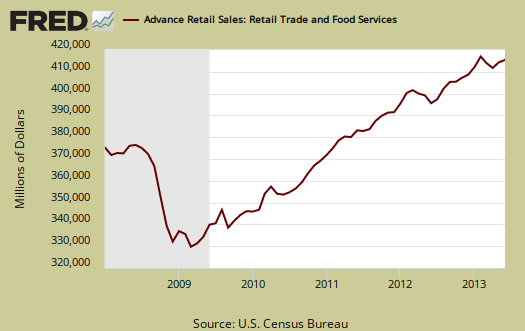
For the three month moving average, from April to June (Q2) in comparison to January to March (Q4), retail sales have increased 0.8%. The retail sales three month moving average in comparison to a year ago is up 4.6%. This implies some fairly weak spending for Q2 overall as shown the below graph of quarterly annualized retail sales percentage change.

Retail trade sales are retail sales minus food and beverage services. Retail trade sales includes gas, and is up 0.6% for the month and has increased 13.8% from last year.
Total retail sales are $422.8 billion for June. Below are the retail sales categories monthly percentage changes. These numbers are seasonally adjusted. General Merchandise includes super centers, Costco and so on. Online shopping making increasing gains, increasingly important in overall retail sales. Online shopping continues to expand as nonstore retail sales have increased 13.8% from last year.
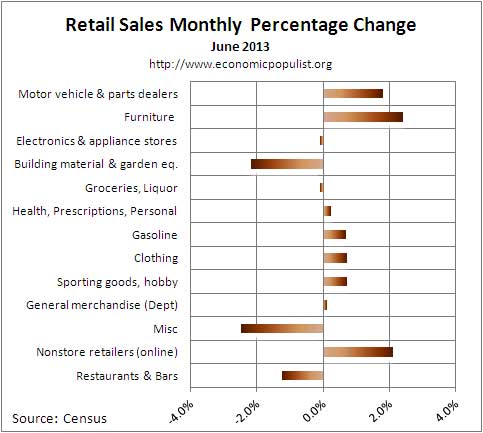
Gasoline station sales have increased 4.3% from one year ago. Sporting goods, hobbies, books & music sales have increased 3.4% from last year. Motor vehicles & parts sales overall have increased 11.4% from last year. The ones that are hurting are Departments stores. Their retail sales are down -5.1% from June 2012 with general merchandise stores overall are up 1.1% from a year ago. Building materials, garden sales, which are large by volume, have increased 9.4% from a year ago. Grocery stores have increased sales by 1.9% from this time last year. Below are the June retail sales categories by dollar amounts. As we can see, autos still rule when it comes to retail sales. We also see that electronics, which is down -0.3% from a year ago, is much smaller by total dollars than motor vehicle sales. This implies there is a hell of a lot of hype around smart phone sales in terms of the overall economy.
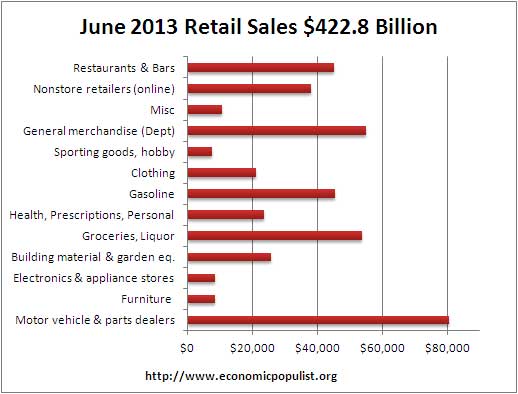
For reference sake, graphed below are weekly regular gasoline prices, so one can see what happened to gas prices in June. Just recently gasoline prices have been soaring.

The below pie chart breaks down the monthly seasonally adjusted retail sales by category as a percentage of total June sales by dollar amounts. One can see how dependent monthly retail sales are on auto sales by this pie chart. We also see non-traditional retailers making strong grounds on traditional general merchandise stores.
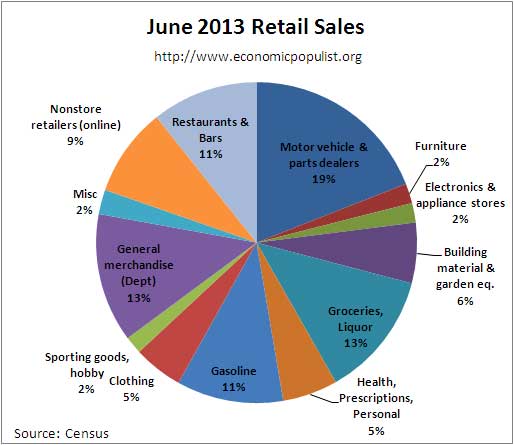
Retail sales correlates to personal consumption, which in turn is about 70% of GDP growth. Yet GDP has inflation removed from it's numbers. This is why Wall Street jumps on these retail sales figures. Below is the graph of retail sales in real dollars, or adjusted for inflation, so one gets a sense of volume versus price increases. Below is the annualized monthly percentage change in real retail sales, monthly, up to May 2013.
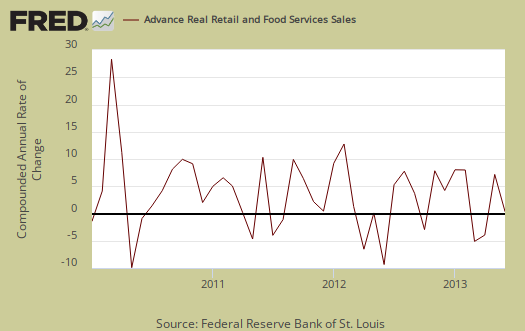
To obtain real values, retail sales are deflated using CPI. Below are the real retail sales quarterly annualized percent change. The graph displays up to Q1 2013.
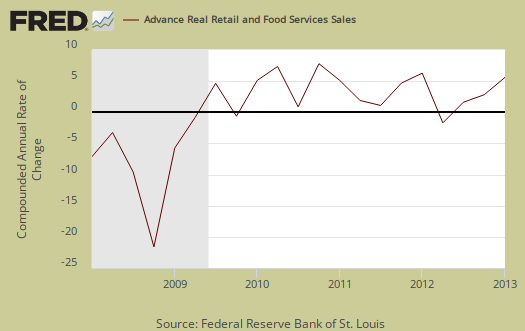
Below is a graph of real PCE against real retail sales, quarterly. See how closely the two track each other? PCE almost looks like a low pass filter, an averaging, removal of "spikes", of real retail sales. Here are our overviews for PCE. Here are our overviews of GDP.

Retail sales are not adjusted for price increases, not reported in real dollars. Real economic growth adjusts for inflation. Retail sales has variance, margins of error, and is often revised as more raw data comes into the U.S. Department of Commerce (Census division). For example, this report has an error margin of ±0.5%. Data is reported via surveys, and is net revenues of retail stores, outlets. Online retail net revenues are asked in a separate survey of large retail companies (big box marts). This is also the advanced report. To keep the monthly nominal percentage changes in perspective, below is the graph of monthly percentage changes of retail sales since 2008.
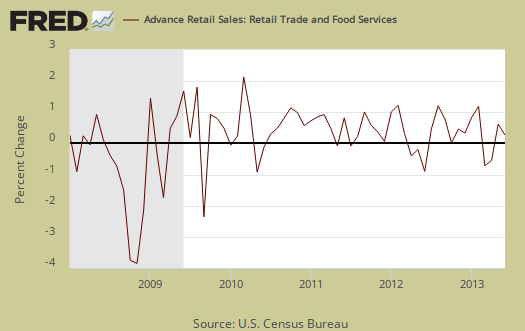
Seasonal adjustments are aggregate and based on events like holidays associated with shopping, i.e. the Christmas rush. Advance reports almost always are revised the next month as more raw sales data is collected by the Census. In other words, do not get married to these figures, they will surely be revised. Here is our retail sales topic category.
Here are past retail sales overviews, unrevised.

May revision
May's sales gain was reportedly revised down from 0.6% to 0.5% but the actual change was from a gain of .00550806991% to .00536788767%, practically unchanged...i bring it up cause i couldnt see the difference until i did the math...
rjs
rounding
I don't have the error margin off hand, but this is true on many of the economic reports, the revision looks better or worse due to significant digits but figuring out the validity of significant digits on these is a lot of work!